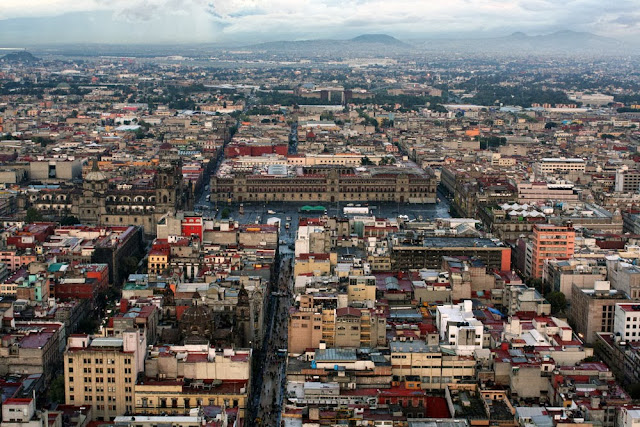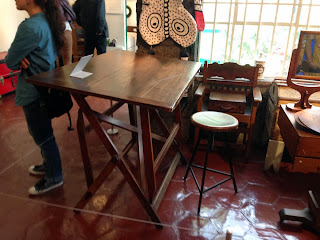 |
| Mexico City's Zócalo, as seen from the Torre Latino Americana |
We got married! And went to Mexico for our honeymoon in search of good food, good drinks and cities to explore. Our first stop: Mexico City.
Our time in the Mexican capital didn't get off to the smoothest start — the airline lost Ben's bag, our taxi driver couldn't find our street and our AirBnB apartment was a bit of a disappointment.* For dinner, we found a restaurant that served stuffed baked potatoes (and nothing else) and when I asked to see a menu, the waiter replied with a two-minute stream of Spanish, of which my tired, jet-lagged brain only understood the words "pico de gallo." It was an abrupt welcome back to Latin America.
 |
| Many streets are lined with foods stands. |
Day 1: The Day When Nothing Is Open
Our first day here was Mexican independence day, which Mexico takes quite seriously (though they didn't succeed in defeating the Spanish for 11 more years). We had booked our trip around our wedding, not around Mexican holidays, and hadn't realized everything in the city would be closed today. We just wandered around, got a feel for the city and witnessed some of the military celebrations, including aerial flyovers and commandos hanging by ropes from helicopters.
Mexico was full of patriotic, historic and military symbolism, maybe even more than in the U.S., but one thing Ben observed was the way the colonial story is the reverse of that at home. The American historical "we" is the European colonists — we got tired of the British crown, we fought them, we won and called the country America; and by the way, there were some native people here who were in our way. In Mexico, the "we" is the indigenous people — we are Mexicans, we were invaded by the Spanish, we fought them off.


On the right is caldo xochitl (pronounced so-sheel), one of my favorite food discoveries. It's basically chicken broth with rice, but topped with typically Mexican ingredients including cilantro, lime and avocado.
At dinner, we encountered our first "weird" food — worm salt (or sal de gusano). It's made of salt, ground chiles and powdered worm and it rimmed the glass of my mango cocktail. We weren't that grossed out by it (Ben wasn't quite sure whether to believe me when I told him that I was pretty sure that gusano translated to worm), but we won't be rushing out to buy it anytime soon. On the upside, our pumpkin gnocchi and chipotle penne were downright delicious.
Our first impressions of the city: it rains a lot (this being the rainy season), the architecture in the colonial center is impressive and it's not the most pedestrian-friendly place (we kept dashing across roads without crosswalks to reach the metro).
 |
| Museo Nacional de Antropología |
Day 2: The Day With The Museums
Mexico City is famous for its museums and to avoid museum fatigue, we decided to focus on the ones in Chapultepec Park, including the Museo Nacional de Antropología. It traces Mexico's pre-Hispanic cultures up until the Spanish conquest and provided a good introduction to the ruins we would visit later in the trip. Ben wondered why the indigenous cultures in the United States didn't create civilizations on the scale of Teotihuacan or Chichén Itzá. The best guess we could come up with was that the climate in Mexico allowed the tribes there to settle down in a way that wasn't possible in the U.S. — but that's just a guess.
We tried to also visit the Museo Nacional de Historia, but some byzantine rules about lockers prevented us from entering and instead we wasted some money going to the Museo de Arte Moderno, where most of the exhibits were closed. We made up for this by enjoying Argentine food and Latin music for dinner. We should note that we were surprised at how safe we felt walking home at night in Mexico City. Granted, we were staying in a nice neighborhood, but it felt much safer than our nice neighborhood in Buenos Aires.
Day 3: The Day With A Million Policemen
See those policemen in the photo? That's maybe 1% of the policemen we saw this day — seriously, there were thousands of riot police blanketing downtown Mexico City. At first we wrote them off as a product of Mexico's drug war, especially since they didn't seem to be doing anything. They let us pass through to visit the Catedral Metropolitana, which is the largest cathedral in Latin America (though if you're looking for grand cathedrals, go to Europe).
For lunch, we tried to eat at a Spanish restaurant recommended by our guidebook for having a great menu del dia (the Spanish-style fixed lunch menu common across Latin America). It occupied the first and second floors of an elaborate old mansion. The first floor was an unappealing cafeteria where the staff directed us to the second floor. There everyone was dressed in tuxes, the waiters put our napkins in our laps and gave us funny looks for our casual clothes. So we decided that wasn't the right place and left. We wandered into a random taquería and enjoyed one of our favorite meals in Mexico.
 |
| Mexico City after the rain |
Just as we're standing outside the closed palace, it starts to pour. This would have to be the low point of our time in Mexico — everything was closed, we were soaking wet and hadn't found much we liked about Mexico City. Fortunately, after a hot chocolate, things started to turn around for us. We made it to the Museo Mural Diego Rivera just before closing, where we enjoyed studying the mural Dream of a Sunday Afternoon in Alameda Park, we got a great view of the city from the Torre Latino Americana and enjoyed a much more successful final two days in Mexico City.
 |
| View from the Torre Latino Americana |
Day 5: The Day In Which We Finally Like Mexico City
First point in the city's favor today: the most delicious French toast at a bookstore cafe (it almost tasted like fried dough) with mango jelly on the side. We were spending the day in Coyoacán, described in our guidebook as one of city's most traditional neighborhoods, whose plazas and narrow cobblestoned streets are marvelous places to stroll and appreciate the neighborhood's relaxed ambience. We enjoyed the Museo Frida Kahlo, located in the house where Frida grew up, and where she and Diego Rivera lived for many years. The house was filled with her art, clothes (of a distinctive traditional style that covered her injuries), her mole recipe, and a beautiful revival of her garden. (We were inspired by the museum to rent the great movie Frida, starring Salma Hayek, to watch in the airport on the way home.)
 |
| Spot the gringa at the Museo Frida Kahlo, also known as the Blue House or La Casa Azul. |


On the left, Frida Kahlo's easel, which was a gift from Nelson Rockefeller; on the right, the kitchen where Frida and Diego cooked using pre-Hispanic methods.
A few blocks away was the Museo Casa de Leon Trotsky, which was a total bust. Trotsky was exiled from Russia by Stalin, who murdered his children and eventually him in Mexico — where he lived with Frida and Diego before moving into his own house — but we wanted to understand what their ideological fight was about, and why the artists were so drawn to him. The museum didn't bother to explain any of this.
After lunch, we hurried over to the Museo Nacional de las Intervenciones, a museum dedicated to all the invasions Mexico has suffered, including by Spain, France and the United States (three different times). The museum was hosted in a former convent, but we didn't know this when we entered. The first room was a kitchen with information about nuns and eating utensils. Then there were several rooms with pictures of saints and religious artifacts, with no mention anywhere of invaders. Ben was convinced we had come to the wrong museum, and was about to leave and ask for our money back, when we found a large case of guns. The convent had later been turned into a fort and was the site of a major battle. We were in the right place after all.
We got a good overview of Mexican history, though I was amused that our book had claimed that "all sides are treated fairly and without animosity in the displays" — what with calling the wars with the Americans unjust and referring to Victor Huerta as the usurper rather than as the president, the exhibits hardly seemed unbiased.
 |
| The main plazas in Coyoacán |
For our first four days in Mexico, we had barely eaten vegetables (except the tomatoes and avocados included in basically every dish) and at the beginning of the day, I commented that all I wanted was salad and gazpacho, figuring there was little chance of finding either. Mexican water isn't safe to drink, which means a lot of lettuce isn't safe to eat either, and some people stay away from salads their entire trip. I didn't think I could survive two weeks of meat and tortillas, and at lunch at a nice restaurant on Coyoacán's main plaza, we both risked ordering salads, which turned out to be delicious and safe to eat. I couldn't believe my luck when we later wandered past a restaurant serving gazpacho. We came back for dinner and the gazpacho was easily the best I've had outside of Spain (and possibly including the gazpacho in Spain). I loved my first bowl so much, I ordered a second bowl.
We spent part of the evening sitting in the public square in Coyoacán, which was one of our favorite spaces in the city with its festive and communal yet peaceful atmosphere. It was a great way to bid goodbye to Mexico City.
- Steph
Here are a few more of our favorite Mexico City photos. To see the captions, you must view it full-screen and choose "show info".
* After a good experience with AirBnB in Buenos Aires, we've had one horrible experience, one poor experience and one mediocre experience, which has us wondering if we should continue to use it anymore.
Keep reading: Pre-Hispanic ruins































